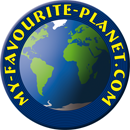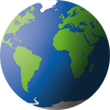|
|
|
| My Favourite Planet > English > Europe > Greece > Attica > Athens > galleries > Acropolis |
|
| |
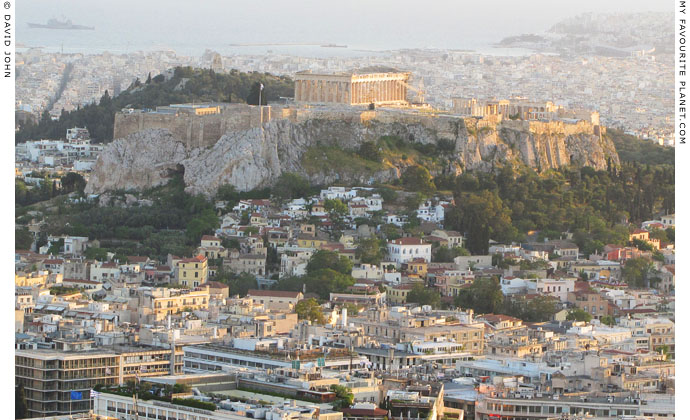
The northwest side of the Acropolis from Mount Lykavittos. Beyond, the Bay of Phaleron and Piraeus. |
What would Athens be without its most famous landmark - or trademark - and biggest tourist attraction? London without Saint Paul’s Cathedral, New York without the Empire State Building or Paris sans Eiffel Tower would probably remain pretty much the same cities, but the "city of Theseus" without its "high city" is unimaginable.
The rock has provided refuge and protection for the inhabitants of the Athenian plain since at least the Stone Age. The early farmers and fisher folk reinforced this natural fortress and it became the home of their kings and their gods. It was principally sacred to the goddess Athena, but other deities and heroes were also worshipped here. Through success in trade and war, the city became prosperous, allowing the Athenians to erect grand temples and sculptures which became famous throughout the world.
Athens lost its wealth, power and influence to foreign powers: Macedonians, Romans, Byzantines, Franks, Ottoman Turks. For many centuries the city became a provincial town, its gods and temples forgotten, the Acropolis merely a fortress for a succession of foreign rulers. Today the rock is once more a vital focal point of world culture, a flagship of Greek identity and one of the most important single factors in the country's tourist economy. |
|
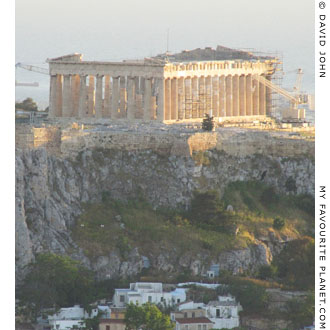
The Parthenon |
|
| |
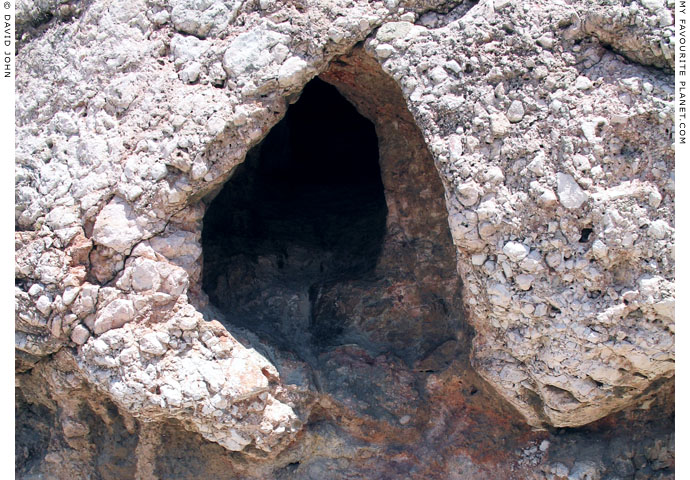
One of the mysterious niches in the rock of the Acropolis.
|
Most plans of the Acropolis show its famous temples and monuments. However, all over and around the porous limestone rock are natural and man-made niches, caves and springs which have served religious and practical purposes over thousands of years.
Around the foot of the rock are the remains of several sanctuaries of deities, greater and lesser, as well as nymphs and other mythical beings worshipped by Athenians.
See images and information about:
The Klepsydra spring and other ancient sanctuaries
on the north slope of the Acropolis: gallery pages 4 and 5.
The Choragic Monument of Thrasyllus on the
south slope of the Acropolis: gallery page 35. |
|
|
| |
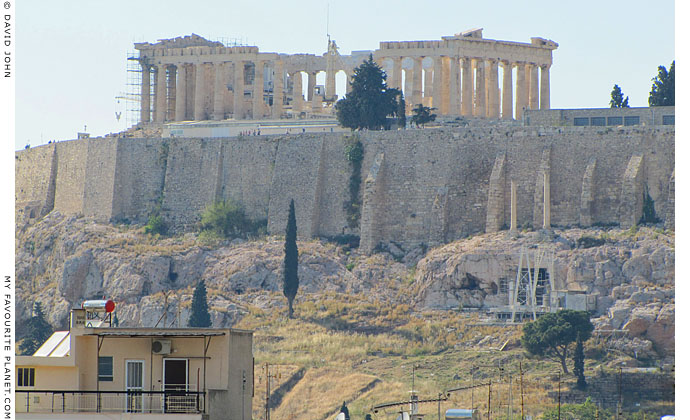
The Parthenon and the south walls of the Acropolis, viewed from the terrace of the new
Acropolis Museum. Just beneath the walls, right, is the Choragic Monument of Thrasyllos,
above the upper tiers of seating of the Theatre of Dionysos. |
| |
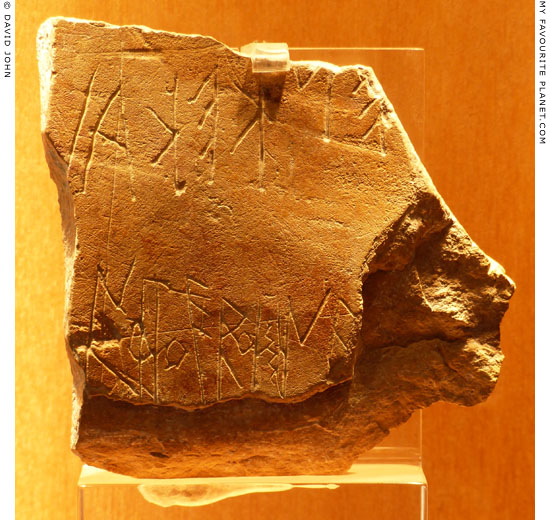
The earliest Attic graffito on stone. From the Athenian Acropolis, 8th century BC.
Limestone. Height 8.2 cm, width 8.1 cm, thickness 1.5 cm.
Epigraphical Museum, Athens. Inv. No. EM 5365.
|
The small fragment of limestone, found on the Athens Acropolis, has early Greek lettering scratched on one side, and is thought to be the oldest graffito from Attica yet discovered. From the form of the lettering, epigraphists believe that it was written during the 8th century BC, possibly around 700 BC.
This also makes it one of the earliest examples of writing using the Greek alphabet, which was an adaptation of the Phoenician alphabet. The art of writing in prehistoric Greece is known from the Linear A and Linear B scripts used by the Minoan and Mycenean cultures, but was lost after the fall of these civilizations and the ensuing "Dark Ages" of the 12th - 8th centuries BC.
It is thought that the Greeks adapted the Phoenician alphabet during the mid 8th century BC, although the location of this discovery is still debated. The Greeks added letters for vowels which the Phoenician script lacked, and it seems that this new form of writing was spread relatively rapidly through many Greek cities, aided by the increasing trade around the Eastern Mediterranean and a wave of Greek colonization (see History of Stageira and Olympiada - Part 2).
What remains of the graffito consists of 17 characters on two lines, written boustrophedon [1]. The top line is written from right to left, with the letters reversed, and the bottom line from left to right (see illustration below). The style of writing has been referred to as "runic" because of its similarity to early Germanic scripts of the 3rd century AD and later. |
|
|
| |
Transcription and translation
of the graffito:
– – ἐνκεκάλ̣[υπται]
– – ἀνφτο έροισ̣ι̣ν ἐ– –
– – therein is hidden
– – both –
Inscription IG I (3) 1418. [2] |
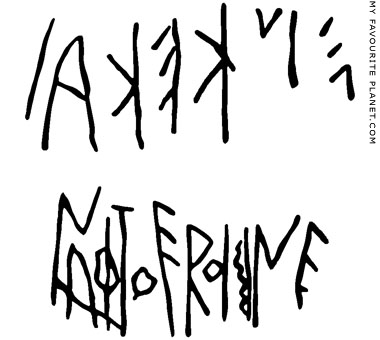
A copy of the lettering of the graffito. |
|
 |
|
|
| |
| |
 |
| |
 |
| |
 |
| |
 |
| |
 |
| |
 |
| |
George Alvanos
rooms in
Kavala's historic Panagia District
Anthemiou 35,
Kavala, Greece
kavalarooms.gr
|
| |
Olive Garden Restaurant
Kastellorizo,
Greece
+30 22460 49 109
kastellorizo.de
|
| |
Papoutsis
Travel Agency
Kastellorizo,
Greece
+30 22460 49 286
greeklodgings.gr
|
| |
| |
| |

Reconstructed fragments of a marble
stele inscribed with the oldest known
decree of the Athenian assembly
(demos) concerning the settlement of
Athenians, possibly cleruchs (lot-holders,
see History of Stageira part 3), on the
nearby island of Salamis. The settlers
were liable to tax and military service.
This, the earliest known political decision
by the newly-established democracy,
led to a long period of hostility between
the city state and neighbouring Megara.
508/507-500 BC.
Epigraphical Museum, Athens.
Inv. Nos. EM 6798 + 6798a
+ 6815 + 12936 + 13500.
Inscription IG I(3) 1 + Add. et Corr. p. 935. |
|

"The decree of Themistokles", believed by some scholars
to be a faithful copy of a decree issued by the Athenian
general Themistokles on measures concerning the
Persian invasion of Greece in 481-480 BC.
First half of the 3rd century BC.
Found at Troezen, northeastn Peloponnese.
Epigraphical Museum, Athens.
Inv. Nos. EM 13330.
Inscription: Hesperia 29, 1960, pages 198-223. |
|
| |

Fragments of a stele inscribed
vertically in boustrophedon,
concerning the reorganization
of the Great Panathenaic Festival.
Probably around 562-558 BC.
The Great Panathenaia, held every
four years, was reorganized around
566 BC by the tyrant Peisistratos
(Πεισίστρατος), who ruled Athens for
most of the period 561-527 BC.
Epigraphical Museum, Athens.
Inv. Nos. EM 6214, 6215, 6224,
6226. Inscription IG I(3) 508. |
|
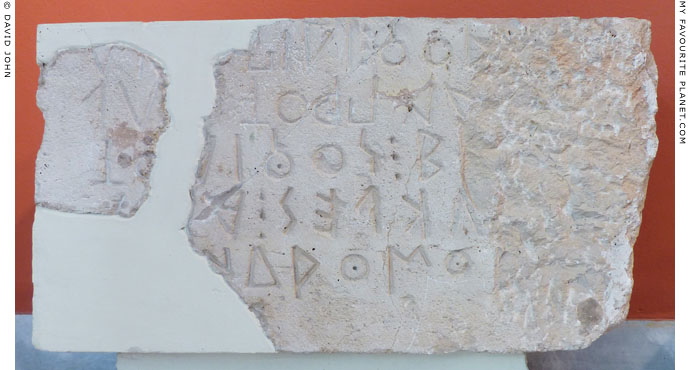
A limestone stele dedicated on the Acropolis, with an inscription
concerning the dromos for the first Panathenaic Games. 570-560 BC.
The games were instituted around 566 BC as part of
Peisistratos' reorganization of the Panathenaic Festival.
Epigraphical Museum, Athens. Inv. No. EM 6212. Inscription IG I(2) 463. |
|
| |
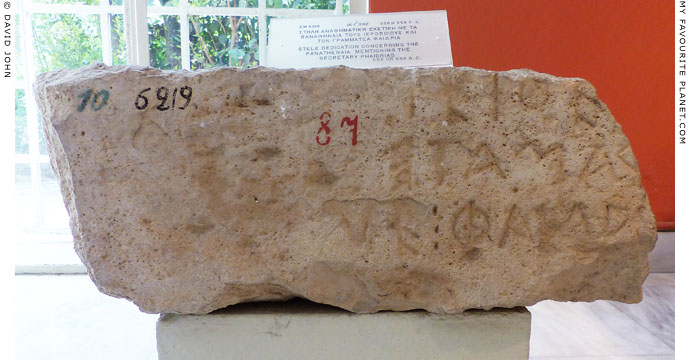
Part of a stele inscribed with a dedication concerning the Panathenaic Festival
and mentioning the secretary Phaidrias. 558 or 554 BC.
Epigraphical Museum, Athens. Inv. No. EM 6219. Inscription IG I(2) 392. |
| |
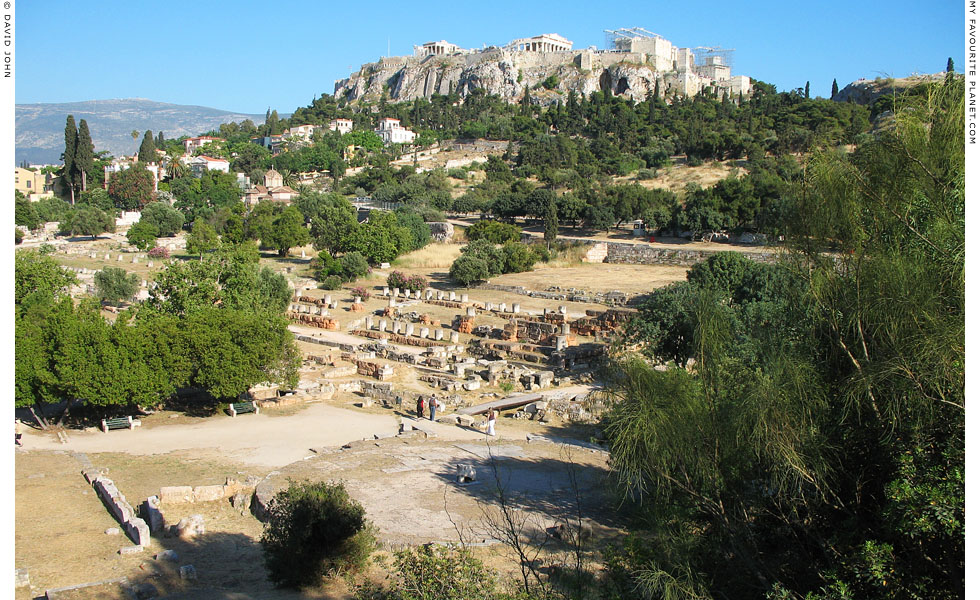
The north side of the Acropolis, viewed from the (the Hephaisteion),
across the ancient Agora. To the right (west) of the Acropolis is the
Areopagus Hill, and on the left in the distance is Mount Hymettos. |
| |
Acropolis
Athens |
Notes, references, links |
 |
|
1. Boustrophedon
The word boustrophedon is from the Greek βουστροφηδόν (ox-turning), from βοuς (bous, ox), στροφή (strophe, turn) and δόν (don, an adverbial suffix), and means turning in the opposite direction, as an ox at the end of each row of ploughing.
In the study of ancient manuscripts and inscriptions it denotes texts in which the direction of the writing changes direction on every other line: one line is written from left to right, and the next from right to left, with the letters reversed. It appears in texts from several ancient cultures, and in Greece it was used mainly in the Archaic period (8th - early 5th centuries BC), and gradually less through the Classical and Hellenistic periods.
2. The transcription of the text can also be found at:
epigraphy.packhum.org/text/1637
Searchable Greek Inscriptions, at The Packard Humanities Institute.
With a German translation: http://pom.bbaw.de/ig/IG%20I%C2%B3%201418
Inscriptiones Graecae, at Berlin-Brandenburgische Akademie der Wissenschaften, Berlin. |
|
|
Photos, illustrations, maps and articles: © David John,
except where otherwise specified.
Additional photos: © Konstanze Gundudis
All photos and articles are copyright protected.
Images and materials by other authors
have been attributed where applicable.
Please do not use these photos or articles without permission.
If you are interested in using any of the photos for your website,
project or publication, please get in contact.
Higher resolution versions are available on request.
My Favourite Planet makes great efforts to provide comprehensive and accurate information across this website. However, we can take no responsibility for inaccuracies or changes made by providers of services mentioned on these pages. |
|
| |
 |
Visit the My Favourite Planet Group on Facebook.
Join the group, write a message or comment,
post photos and videos, start a discussion... |
|
|
| |
| Copyright © 2003-2025 My Favourite Planet | contents | contributors | impressum | sitemap |
| |
